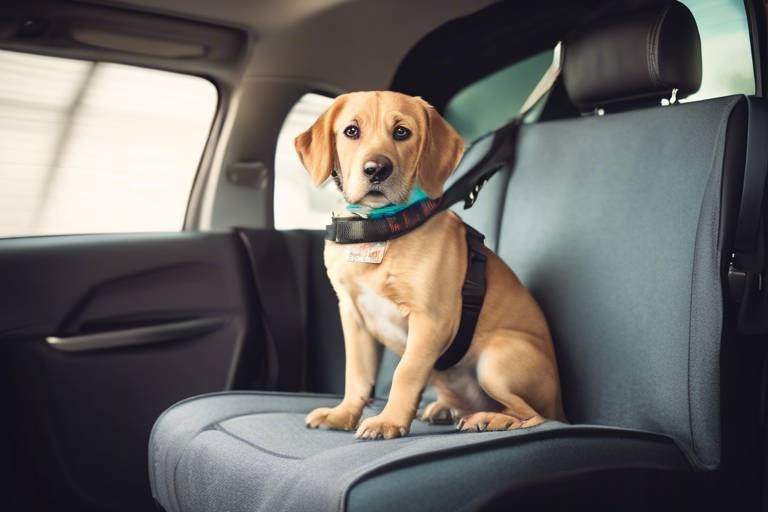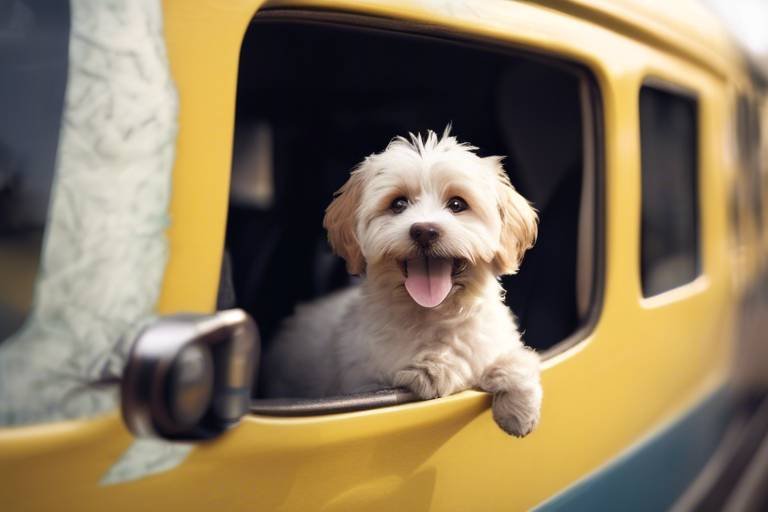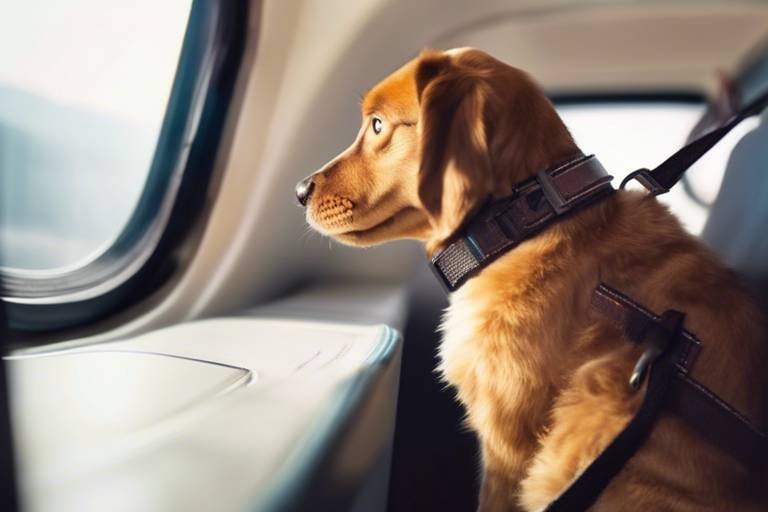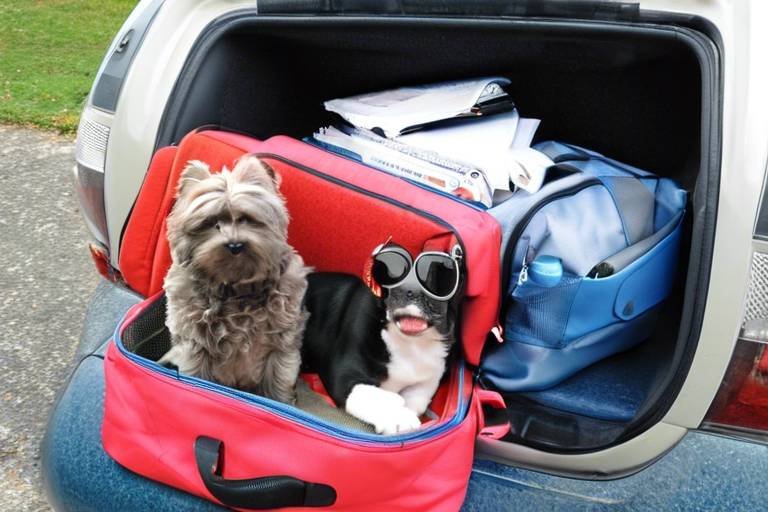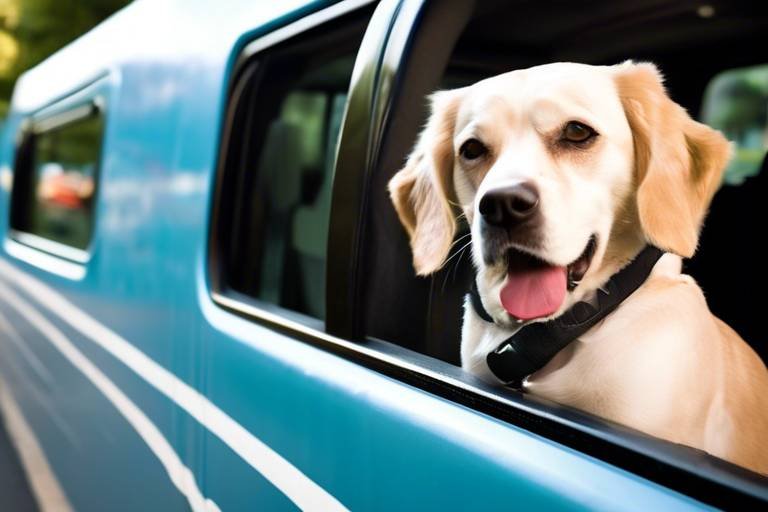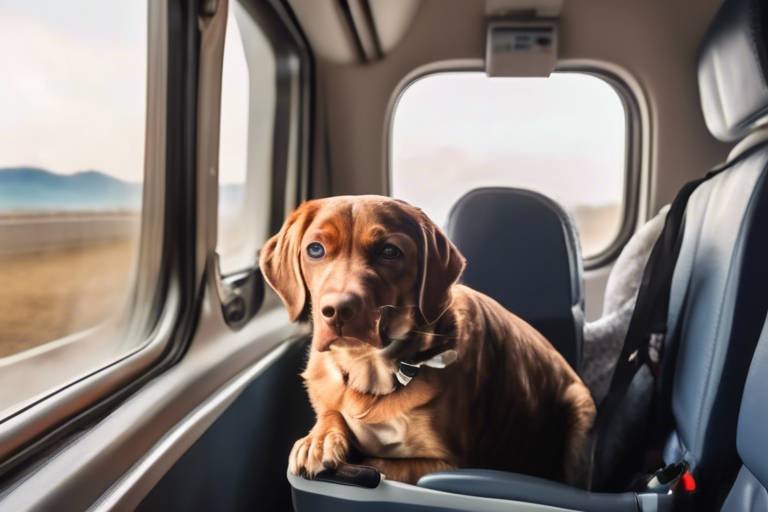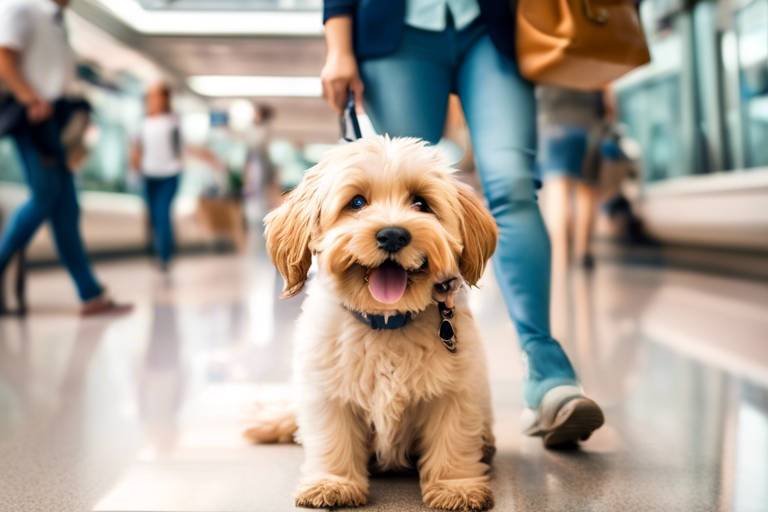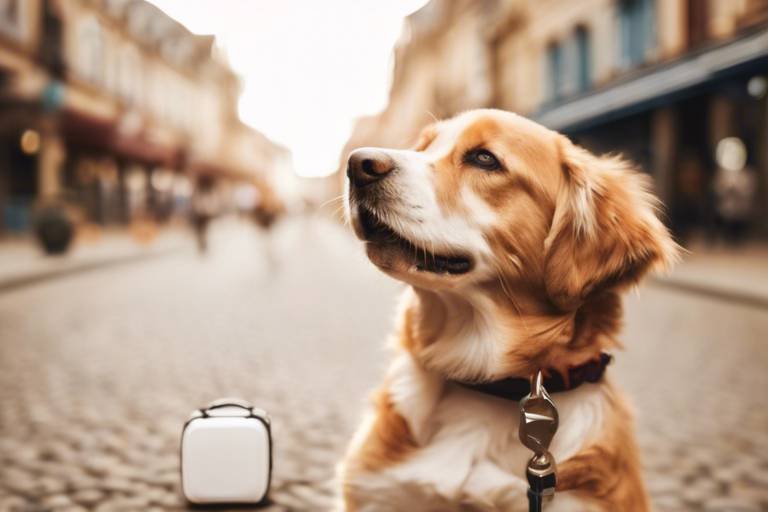Tips for Finding Pet-Friendly Transportation
Traveling with your furry companions can be one of the most rewarding experiences, but it also comes with its own set of challenges. As a pet owner, ensuring your beloved pet has a comfortable and safe journey is essential. Whether you're planning a short road trip or a long-haul flight, understanding the ins and outs of pet-friendly transportation is key to a smooth adventure. So, how do you navigate the maze of options available? Let's dive into some essential tips that will help you find the perfect transportation for you and your pet.
First and foremost, it's important to recognize that not all transportation services are created equal when it comes to accommodating pets. Each mode of transport—be it air travel, train, or bus—comes with its own set of rules and regulations. This can feel overwhelming, but don't fret! With a little research and preparation, you can find options that work for both you and your furry friend. Think of it as planning a road map for an exciting journey: the more detailed your plan, the smoother your ride will be.
When considering transportation, always start with a thorough understanding of the pet policies associated with different services. For example, airlines often have specific guidelines regarding crate dimensions, weight limits, and even health documentation. On the other hand, trains and buses might have more relaxed rules but could still impose restrictions based on the size and temperament of your pet. It’s like shopping for a new home; you wouldn’t want to settle for a place that doesn’t fit your needs, right? Take the time to gather this information before making any bookings, as it can save you from unexpected surprises down the road.
Once you have a grasp on the pet policies, the next step is to evaluate the different modes of transport available. Air travel can be a bit daunting, especially for first-time flyers. However, with the right preparations, it can be a breeze! If your pet is small enough, you may be able to keep them in the cabin with you, which can ease anxiety for both of you. Larger pets, however, may need to travel in the cargo hold, which comes with its own set of considerations. The key is to choose the option that best suits your pet's size, temperament, and the distance you plan to travel.
In addition to air travel, don’t overlook the advantages of train and bus travel. Many major rail and bus companies have become increasingly pet-friendly, offering various levels of accommodation. For instance, some trains allow pets in carriers on board, while others may have designated pet-friendly cars. Similarly, certain bus lines may permit pets provided they are in carriers. This can be a fantastic alternative for those who want to avoid the hustle and bustle of airports. Imagine the joy of watching the scenery whiz by while your pet relaxes comfortably by your side!
So, as you embark on your journey, remember that preparation is key. Whether you're flying high or cruising down the highway, making sure your pet is comfortable and secure will make all the difference. By understanding pet policies, choosing the right mode of transport, and preparing adequately, you can ensure a delightful travel experience for both you and your furry friend. Now, let's explore the next steps in your travel planning process, including booking accommodations and preparing for any emergencies that may arise during your journey.
- What should I do if my pet is anxious during travel? Consider using calming products or consult your vet for recommendations on anxiety relief.
- Are there specific airlines that are better for traveling with pets? Yes, some airlines are known for their pet-friendly policies. Research and read reviews to find the best options.
- Can I take my pet on public transportation? Many public transport systems allow pets, but policies vary widely, so check ahead of time.
- What should I pack for my pet when traveling? Essentials include food, water, a leash, waste bags, and any medications your pet may need.

Understanding Pet Policies
When it comes to traveling with your beloved furry friend, is absolutely crucial. Not all transportation services treat our pets the same way, and knowing what to expect can save you from potential headaches down the road. Imagine planning a perfect getaway only to discover that your pet can't join you because of strict regulations! That's why doing your homework is essential before you book anything.
Different modes of transportation have their own set of rules regarding pets. For instance, airlines may have specific requirements for pet carriers, while trains and buses might allow pets but restrict their size or require them to be leashed at all times. It's like navigating a maze—one wrong turn, and you could end up in a situation you didn’t plan for. To make things easier, here’s a quick breakdown of what you might encounter:
| Transportation Mode | Pet Policy Highlights |
|---|---|
| Airlines | Varied pet fees, crate size limitations, and cabin vs. cargo travel. |
| Trains | Generally allow small pets, often require them to be in carriers. |
| Buses | Most allow pets, but size restrictions and additional fees may apply. |
Before you book, make sure to read the fine print. Look for information on pet fees, size restrictions, and any necessary documentation. Some airlines even require a health certificate from your vet, while others may have specific breed restrictions. It’s like a game of chess—every move counts, and you need to be strategic to ensure your pet’s comfort and safety.
Moreover, it’s important to consider your pet's personality and health. If your dog gets anxious in crowded places, flying might not be the best option. On the other hand, if your cat is calm and collected, a long train ride could be a delightful adventure. Remember, your pet’s well-being should always be a top priority.
In summary, understanding pet policies is about more than just knowing the rules; it’s about ensuring a smooth and enjoyable experience for both you and your pet. So, take the time to research, ask questions, and prepare accordingly. Your furry friend deserves the best, and with the right information, you can provide just that!
- What should I do if my pet is not allowed on my chosen transport? Consider alternative modes of transport or look for pet-friendly services.
- Are there any specific health requirements for pets traveling by air? Yes, many airlines require a health certificate issued by a veterinarian.
- Can I take my pet on the bus or train without a carrier? Most services require pets to be in carriers, but policies may vary, so check ahead.

Choosing the Right Mode of Transport
When it comes to traveling with your furry friend, choosing the right mode of transport is crucial for a smooth journey. Not all transportation options are created equal, and what works for one pet may not work for another. Understanding your pet's needs, such as their size, temperament, and the distance you plan to travel, can significantly influence your decision. For instance, while some pets thrive in a bustling environment, others may feel overwhelmed. So, how do you determine the best option?
First, let's break down the most common modes of transportation:
- Air Travel: Ideal for long distances but comes with strict regulations.
- Train Travel: Offers a relaxed environment, often with more space for pets.
- Bus Travel: Generally budget-friendly but can be less accommodating for larger pets.
- Car Travel: The most flexible option, allowing for frequent breaks and comfort.
Each mode has its pros and cons, and it’s essential to weigh these against your pet's characteristics. For example, if you have a small dog that enjoys being around people, flying might be a viable option, especially if you choose an airline that allows pets in the cabin. However, if your pet is larger or more anxious, driving might be the way to go. Think of it like choosing a restaurant: you wouldn’t pick a place that only serves food your friend is allergic to, right? Similarly, you want to pick a transport method that suits your pet's needs.
Another consideration is the duration of your journey. If you’re planning a short trip, a bus or train might be more convenient. However, for long-distance travel, flying could save you time and energy. Just remember, if you opt for air travel, make sure to check the specific airline’s pet policies, as they can vary greatly. Some may allow pets in the cabin, while others require them to travel in the cargo hold. This can significantly affect your pet's comfort level and overall travel experience.
Additionally, consider your pet’s health and age. Older pets or those with health issues may not handle the stress of air travel well. In such cases, a leisurely car ride might be the best choice, allowing you to monitor your pet's condition closely and make stops as needed. Just like a road trip with friends, you can take breaks, enjoy the scenery, and ensure your pet is comfortable throughout the journey.
Ultimately, the right mode of transport is about finding the perfect balance between convenience for you and comfort for your pet. Take the time to assess your options, and don’t hesitate to reach out to fellow pet owners or online forums for advice. After all, the goal is to ensure that both you and your furry companion arrive at your destination happy and stress-free!
Q: Can I take my pet on a plane with me?
A: Yes, many airlines allow pets in the cabin, but it's essential to check their specific policies and book in advance.
Q: Are there size restrictions for pets on trains?
A: Generally, trains have size restrictions, so it's best to confirm with the specific rail company before traveling.
Q: What should I do if my pet gets anxious during travel?
A: Consider consulting your veterinarian for advice on calming techniques or medications that can help during the journey.
Q: How can I ensure my pet's safety during a car trip?
A: Use a pet seatbelt or carrier, and take regular breaks to let your pet stretch and relieve themselves.
Air Travel Considerations
When it comes to flying with your furry companion, there’s a lot to consider to ensure a smooth journey for both of you. First and foremost, it's essential to dive into the airline regulations. Each airline has its own set of rules regarding pet travel, which can vary significantly. Some airlines allow pets in the cabin, while others may require them to be transported in the cargo hold. Understanding these differences can save you a lot of headaches and ensure you don't get caught off guard at the airport.
One of the most crucial aspects of air travel with pets is the crate requirements. Airlines typically have specific dimensions and types of crates that are acceptable for in-cabin and cargo travel. Make sure to measure your pet and choose a crate that complies with the airline’s guidelines. A well-ventilated and comfortable crate can make a world of difference in how your pet experiences the flight. Remember, your pet will be spending a significant amount of time in this space, so it should feel safe and cozy.
To further enhance your pet's travel experience, consider these tips for a stress-free flight:
- Acclimate your pet to the crate well in advance of your travel date.
- Take your pet for a long walk before heading to the airport to burn off some energy.
- Pack familiar items, like their favorite blanket or toy, to provide comfort during the flight.
In addition to understanding airline policies and preparing your pet, it’s vital to know which airlines are the most pet-friendly. Some airlines are renowned for their accommodating policies, offering perks like pet travel kits or dedicated pet areas. For instance, airlines like JetBlue, Southwest, and Alaska Airlines often receive high marks from pet owners for their treatment of animals during travel. However, always check the latest reviews and policies directly on the airline’s website, as these can change frequently.
Lastly, don’t forget to plan for any potential emergencies that may arise during your flight. Always have a list of veterinary services at your destination and along your route, just in case. Being prepared can help ease your mind and ensure your pet's safety.
1. Can I take my pet in the cabin with me?
Many airlines allow pets in the cabin, but they must fit in an approved carrier that fits under the seat in front of you. Always check the specific airline’s policy before booking.
2. What should I pack for my pet's flight?
Pack your pet's favorite toys, a blanket, food, water, and any medications they may need. It's also a good idea to have a leash and waste bags handy for bathroom breaks.
3. How can I help my pet cope with flying?
Acclimate your pet to their travel crate before the trip, and consider consulting your vet about anxiety-reducing options if your pet is particularly nervous.
4. What if my pet needs to go to the bathroom during the flight?
Pets typically won’t need to relieve themselves during short flights, but for longer journeys, make sure to take them for a walk before heading to the airport. Some airlines provide pet relief areas.
Preparing Your Pet for Flight
Traveling with your furry friend can be an exciting adventure, but preparing for a flight requires thoughtful planning to ensure a smooth journey. First and foremost, acclimating your pet to their travel crate is crucial. Start by introducing the crate well in advance of your flight. Leave the crate open in a familiar space, adding your pet's favorite blanket or toy to make it feel like a cozy den. This approach helps reduce anxiety and makes your pet more comfortable with their new travel space.
Next, consider taking your pet on short car rides in the crate. This will help them associate the crate with travel and adventure rather than confinement. Gradually increase the duration of these rides, and soon your pet will be more accustomed to being in the crate for extended periods, like during a flight.
Another important aspect is to visit the veterinarian before your trip. Schedule a check-up to ensure your pet is healthy and up to date on vaccinations. Some airlines may require a health certificate issued by a veterinarian, so it's wise to ask your vet about this during your visit. Additionally, discuss any concerns you may have about your pet's anxiety during travel. Your vet may recommend calming products or medications to help ease their nerves.
On the day of travel, make sure to exercise your pet before heading to the airport. A good play session or a long walk can help burn off some energy, making them more likely to relax during the flight. Remember to feed your pet a light meal a few hours before departure—this helps prevent motion sickness while ensuring they’re not traveling on a completely empty stomach.
When packing for your journey, don’t forget to include essentials such as water, food, and any medications your pet may need. It’s also a good idea to have a leash handy for easy access when you arrive at your destination. If your pet is traveling in the cabin with you, having a small bag with these items can make things much easier.
Finally, familiarize yourself with the specific airline's pet policies. Each airline has its own regulations regarding crate sizes, fees, and documentation. Make sure you have all necessary paperwork in order to avoid any last-minute surprises. By taking these steps, you can help ensure that your pet feels safe and comfortable throughout the flight, making for a more enjoyable experience for both of you.
- What should I do if my pet gets anxious during the flight?
Consider using calming products or consult your veterinarian for advice on medication. - Can I take my pet out of the crate during the flight?
Generally, pets must remain in their crates during the flight for safety reasons. - Are there specific airlines that are better for pet travel?
Yes, some airlines are more pet-friendly than others. Research and read reviews to find the best option for your furry friend. - How can I help my pet adjust to the travel crate?
Introduce the crate gradually, use positive reinforcement, and make it a comfortable space with familiar items.
Finding Pet-Friendly Airlines
When it comes to air travel with your furry friends, not all airlines are created equal. Some airlines roll out the red carpet for pets, while others might leave you feeling like you’re navigating a maze of restrictions and fees. So, how do you find the most pet-friendly airlines? First, do your homework! Check the airline’s website for their specific pet policies, as these can vary widely. For instance, some airlines allow pets in the cabin, while others only permit them in the cargo hold. You’ll want to consider your pet's size and personality when making this decision.
Next, look for airlines that offer special services for pets. Some airlines provide pet travel kits that include a comfortable blanket, food, and water dishes, while others might have dedicated staff to assist pet owners. This can make a world of difference in ensuring your pet’s comfort and safety during the flight. Additionally, consider reading reviews from other pet owners. Websites and forums dedicated to pet travel can offer insights and personal experiences that can guide your decision. You might find that certain airlines have a reputation for being particularly accommodating.
Here’s a quick comparison of some popular airlines and their pet policies:
| Airline | In-Cabin Pet Policy | Cargo Hold Policy | Additional Services |
|---|---|---|---|
| Delta | Yes, under 20 lbs | Available for larger pets | Pet travel kits available |
| American Airlines | Yes, under 20 lbs | Available for larger pets | Dedicated pet travel assistance |
| Southwest | No | No | Not pet-friendly |
| United Airlines | Yes, under 20 lbs | Available for larger pets | Pet-friendly travel program |
Another tip is to call the airline directly. Sometimes, speaking with a representative can provide you with information that isn’t readily available online. They can clarify any questions you have about fees, crate requirements, or specific accommodations for pets. Plus, this can give you a sense of their customer service, which is essential when traveling with a pet.
Lastly, don’t forget to book your pet’s travel in advance. Many airlines have a limited number of spots available for pets in the cabin, and these can fill up quickly. By planning ahead, you not only secure a spot for your furry friend but also reduce stress on the day of travel.
Train and Bus Travel Tips
Traveling by train or bus can be an excellent alternative for pet owners who want to avoid the stress of air travel. Not only can it be more economical, but it often allows for a more relaxed atmosphere where pets can enjoy the journey alongside their humans. However, before you hop on board, it's essential to familiarize yourself with the specific pet policies of the transportation companies you plan to use. Each company has its own set of rules regarding pet travel, and understanding these can save you from unexpected surprises. For instance, some trains may allow pets in carriers, while others might have weight restrictions.
When considering train travel, companies like Amtrak have specific guidelines that allow small pets to travel in carriers. However, larger dogs may need to be left behind unless they are service animals. It's important to check the size limitations and any associated fees. On the other hand, bus services like Greyhound generally have stricter policies, often requiring pets to be transported in the cargo hold. This can be a significant concern for pet owners, as it may not be the most comfortable environment for your furry friend.
To make your travel experience smoother, here are a few tips to keep in mind:
- Book Early: If you're traveling during peak times, securing your spot early can ensure that you get a space for your pet.
- Choose the Right Time: Traveling during off-peak hours can reduce stress for both you and your pet, making the journey more enjoyable.
- Pack Essentials: Bring along your pet's favorite blanket or toy to help them feel more at home during the trip.
Additionally, it's wise to check the availability of pet-friendly seating, especially on trains. Some train cars are designated for passengers traveling with pets, allowing you to keep your furry friend close. Always arrive early to allow for any additional time needed for boarding with your pet. This way, you can avoid the rush and ensure your pet is comfortable and calm.
Moreover, don’t forget to keep your pet's health records handy. In case of emergencies, having proof of vaccinations and any necessary medications can be a lifesaver. If you're traveling long distances, consider planning for breaks where your pet can stretch their legs and relieve themselves. Many train stations and bus depots have designated areas for pets, which can make a significant difference in your pet's comfort level during travel.
In summary, while train and bus travel can present unique challenges, being well-prepared can lead to a positive experience for both you and your pet. By understanding the policies, planning your journey carefully, and ensuring your pet's comfort, you can create a memorable adventure that strengthens the bond between you and your furry companion.
1. Can I take my pet on a train?
Yes, many train services allow pets, but policies vary. Check with your specific train company for their regulations.
2. Are there size restrictions for pets on trains?
Most train companies have size restrictions. Typically, small pets can travel in carriers, while larger pets may need to be left behind or travel in designated areas.
3. How do I prepare my pet for bus travel?
Prepare your pet by getting them accustomed to their carrier and ensuring they have essential items like water, food, and comfort items during the journey.
4. What should I do if my pet gets anxious during travel?
Consider using calming products or consult your veterinarian for recommendations on anxiety relief during travel.

Booking Accommodations
Once you’ve secured your transportation, the next step is to find pet-friendly accommodations that will make both you and your furry friend feel at home. Imagine arriving at your destination after a long journey only to find that your hotel doesn’t allow pets. It’s a nightmare scenario that can easily be avoided with a little planning. Start by using reliable resources that specifically list hotels and rentals that welcome pets. Websites like BringFido and PetFriendly can be invaluable in your search.
When booking, always check the pet policies of the accommodations. Some places may charge additional fees for pets or have restrictions on the size or breed of pets allowed. Be sure to ask about any specific rules, such as whether pets can be left unattended in the room or if they require leashes in common areas. This way, you can avoid any unpleasant surprises upon arrival.
Another great tip is to read reviews from other pet owners. Look for comments that mention how accommodating the staff was towards pets or any challenges other travelers faced. It’s like getting the inside scoop before you book! You might be surprised by how many places go above and beyond to cater to pets, offering amenities like dog parks, pet beds, or even treats upon check-in.
Here’s a quick comparison table of common pet-friendly accommodation types:
| Accommodation Type | Typical Pet Policy | Additional Fees |
|---|---|---|
| Hotels | Varies; often allows pets | Yes, often a non-refundable fee |
| Vacation Rentals | Usually pet-friendly, but check specifics | Varies; some may charge a cleaning fee |
| Motels | Often allows pets | Usually minimal or none |
| Bed & Breakfasts | Varies; some are very pet-friendly | Check for any fees |
It’s also wise to consider the location of your accommodation. Look for places that are near parks or pet-friendly attractions. This not only makes it easier to take your pet for walks but also allows for spontaneous adventures. After all, what’s a trip without a little exploration? You might even find a local pet store or pet-friendly restaurant where you can grab a bite together!
Lastly, don’t forget to pack your pet’s essentials. Bring along their favorite blanket, toys, and any necessary food and medications. Having familiar items can help your pet feel more comfortable in a new environment. And remember, the goal is to create a stress-free experience for both you and your pet, so a little preparation goes a long way.
- What should I look for in pet-friendly accommodations? Always check the pet policy, any additional fees, and read reviews from other pet owners.
- Can I leave my pet alone in the room? This depends on the hotel’s policy; some may allow it while others may not.
- Are there specific breeds that are not allowed? Yes, some hotels have breed restrictions, so always check in advance.
- What are some good websites to find pet-friendly accommodations? Websites like BringFido and PetFriendly are excellent resources.
Using Pet-Friendly Travel Apps
In today's digital age, technology is your best friend, especially when it comes to traveling with your beloved furry companions. Pet-friendly travel apps have emerged as essential tools for pet owners, providing a plethora of options and resources at your fingertips. Imagine being able to find the perfect hotel that welcomes your pet, discover nearby parks for potty breaks, or even locate the nearest veterinarian in case of an emergency—all from your smartphone! Isn’t that a game changer?
When choosing a travel app, consider what features are most important to you and your pet. Some apps focus on accommodations, while others may help you find transportation options or pet-friendly activities. A few popular pet-friendly travel apps include:
- BringFido: This app is a treasure trove of pet-friendly hotels, restaurants, and attractions. It allows you to filter your search based on your pet's size and breed, ensuring you find the right fit.
- PetFriendly: With a user-friendly interface, this app helps you locate hotels, vacation rentals, and campgrounds that welcome pets, along with user reviews to guide your choices.
- DogVacay: If you're looking for pet sitters or boarding options, DogVacay connects you with trusted caregivers who can take care of your pet while you’re away.
These apps not only save you time but also help ease the stress of travel planning. You can read reviews from fellow pet owners, which can provide invaluable insights into the best places to stay and visit. Plus, many of these apps offer exclusive deals and discounts for pet-friendly accommodations, allowing you to save some money while ensuring your pet is comfortable.
Another advantage of using pet-friendly travel apps is their ability to provide real-time information. For instance, if you find yourself in a new city and need a pet-friendly restaurant, you can quickly search for options nearby. Additionally, some apps even include maps that pinpoint pet-friendly parks or walking trails, making it easy to plan your day around your pet's needs.
In case of emergencies, these apps can also be lifesavers. Imagine you’re on a road trip and your pet suddenly falls ill. With a pet-friendly travel app, you can instantly locate the nearest veterinary clinic, ensuring your furry friend gets the help they need without unnecessary delays.
In conclusion, pet-friendly travel apps are not just a convenience—they're a necessity for modern pet owners. They streamline the travel experience, making it easier to find accommodations, activities, and emergency services that cater to both you and your pet. So, before you embark on your next adventure, make sure you download a few of these handy apps. Your pet will thank you!
Q: Are there any costs associated with using pet-friendly travel apps?
A: Most pet-friendly travel apps are free to download and use, although some may offer premium features for a fee.
Q: Can I trust the reviews on these apps?
A: Yes, many apps feature user-generated reviews, which can provide honest insights from fellow pet owners. However, always consider multiple reviews before making a decision.
Q: Do these apps work internationally?
A: Many pet-friendly travel apps include international options, but it's essential to check the app's coverage and availability in your desired destination.
Preparing for Emergencies
Traveling with your furry friends can be an adventure filled with joy and excitement, but it can also come with its fair share of unexpected challenges. Just like you wouldn’t hit the road without a spare tire, it’s essential to be prepared for emergencies when traveling with pets. First and foremost, always have a basic pet first aid kit on hand. This kit should include items like bandages, antiseptic wipes, and any medications your pet might need. Think of it as your pet’s safety net, ready to catch them if anything goes awry.
In addition to a first aid kit, it’s wise to have a list of veterinary clinics along your travel route. You never know when your pet might need a little extra care, and knowing where to go can save you time and stress. You can use apps or websites to locate veterinary services, or simply jot down a few names and numbers before you leave. This way, if an emergency arises, you’ll be ready to leap into action without wasting precious moments.
Moreover, it’s important to have your pet’s medical records handy. These documents can be crucial in case you need to visit a vet while away from home. Make sure to include vaccination records, any chronic conditions, and medications your pet is on. Think of it as your pet's travel passport—essential for ensuring they receive the best care possible, no matter where you are.
Another key aspect of emergency preparedness is ensuring your pet is microchipped or has a collar with an ID tag. If your pet gets lost during your travels, this can be a lifesaver. Imagine the panic of losing your furry companion in an unfamiliar place! A microchip or ID tag can help reunite you quickly. It’s a small but significant step that can make a world of difference.
Lastly, consider having a contingency plan. This means thinking ahead about what you would do if you faced an emergency. For example, if you’re traveling to a new city, know where the nearest emergency vet is located. You might even want to check if they’re open 24/7. Having this information at your fingertips can give you peace of mind and allow you to focus on enjoying your trip.
In summary, preparing for emergencies while traveling with your pet is all about being proactive. With a little planning and the right resources, you can ensure that both you and your furry friend have a safe and enjoyable journey. After all, the adventure should be about creating memories, not worrying about what could go wrong!
- What should I include in a pet first aid kit?
Include items like bandages, antiseptic wipes, tweezers, and any necessary medications. - How do I find a vet in an unfamiliar area?
Use pet travel apps or search online for veterinary clinics along your route. - Is it necessary for my pet to be microchipped?
While not mandatory, microchipping significantly increases the chances of reuniting with your pet if they become lost. - What documents should I carry for my pet?
Carry medical records, vaccination certificates, and any prescriptions your pet may need. - What should I do if my pet has a medical emergency while traveling?
Locate the nearest veterinary clinic immediately and ensure you have your pet's medical information ready.
Frequently Asked Questions
- What should I consider when choosing transportation for my pet?
When selecting transportation, consider your pet's size, temperament, and the length of the journey. Different modes of transport have varying pet policies, so it's essential to research each option thoroughly. For example, airlines may have restrictions on crate sizes, while trains might allow pets to travel in the cabin. Always check the specific policies of the service you're considering.
- How can I prepare my pet for air travel?
Preparing your pet for air travel involves acclimating them to their travel crate well in advance. Start by letting them explore the crate and spend time inside it at home. This helps reduce anxiety. Additionally, consider taking your pet on short car trips to help them get used to traveling. On the day of the flight, ensure your pet has had a good walk and is calm before heading to the airport.
- Are there airlines that are more pet-friendly than others?
Yes, some airlines are known for being more accommodating to pets. Research airlines that offer specific services for traveling pets, such as in-cabin travel options, special pet handling, and even pet relief areas at airports. Airlines like Southwest and JetBlue often receive positive reviews from pet owners. Always check their latest pet policies before booking.
- What are the pet policies for train and bus travel?
Train and bus companies have their own unique pet policies. For instance, Amtrak allows small pets in carriers, while Greyhound has specific requirements for traveling with pets. It's crucial to check the rules of the specific service you plan to use, as they may require advance reservations for pet travel or have restrictions on pet size and weight.
- How can I find pet-friendly accommodations?
Finding pet-friendly accommodations can be a breeze with the right tools. Use pet-friendly travel apps and websites that specialize in listings for hotels and rentals that welcome pets. Additionally, calling ahead to confirm pet policies and any associated fees can save you from surprises upon arrival.
- What should I do in case of an emergency while traveling with my pet?
It's always wise to be prepared for emergencies. Research veterinary services along your travel route beforehand. Keep a list of local vets and pet hospitals handy, and ensure you have a first-aid kit for pets. Additionally, having your pet's medical records and any necessary medications on hand can be a lifesaver in case of unexpected health issues.

